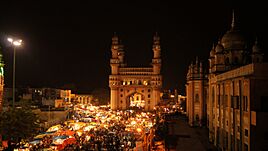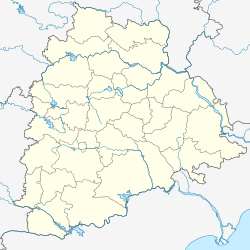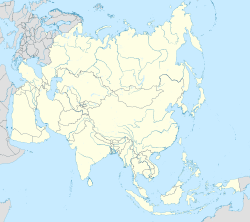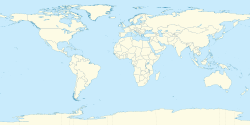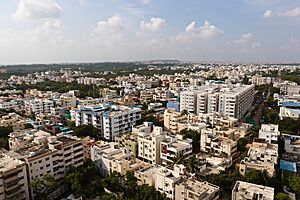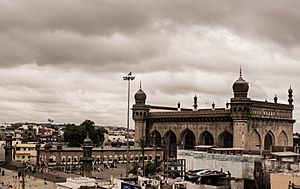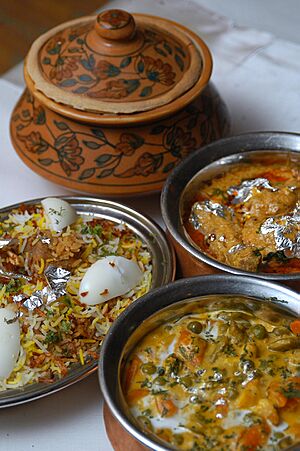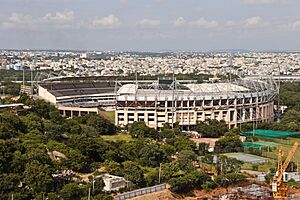Hyderabad facts for kids
Quick facts for kids
Hyderabad
Haidarābād
|
|
|---|---|
|
Clockwise from top: Charminar during Ramzan night bazaar, Qutb Shahi tombs, Buddha Statue at Hussain Sagar, Falaknuma Palace, Buildings in HITEC City Main Road from Raidurg Metro station, and Birla Mandir.
|
|
| Country | |
| State | |
| Districts |
|
| Established | 1591 |
| Founded by | Muhammad Quli Qutb Shah |
| Government | |
| • Type | Municipal corporation |
| • Body |
|
| Area | |
| • City | 650 km2 (250 sq mi) |
| • Metro | 7,257 km2 (2,802 sq mi) |
| Elevation | 524 m (1,719 ft) |
| Population
(2011)
|
|
| • City | 6,809,970 (4th) |
| • Estimate
(2018)
|
9,482,000 |
| • Density | 10,477/km2 (27,140/sq mi) |
| • Urban | 7,749,334 (6th) |
| • Metro | 9.7 million (6th) |
| Demonym(s) | Hyderabadi |
| Time zone | UTC+5:30 (IST) |
| PIN(s) |
500xxx, 501xxx, 502xxx
|
| Area codes | +91–40, 8413, 8414, 8415, 8417, 8418, 8453, 8455 |
| Vehicle registration | TG-07 to TG-15 |
| Official languages | |
| International airport | Rajiv Gandhi International Airport (HYD) |
| Rapid transit | Hyderabad Metro |
Hyderabad is a big and important city in India. It is the capital of the state of Telangana. The city is located on the Deccan Plateau near the Musi River. It has many artificial lakes, like the famous Hussain Sagar. Hyderabad is one of the largest cities in India, with millions of people living there. It is also a major economic hub, meaning it's a very busy place for business and jobs.
The city was founded in 1591 by Muhammad Quli Qutb Shah of the Qutb Shahi dynasty. Later, it became part of the Mughal Empire. In 1724, Asaf Jah I started the Asaf Jahi dynasty, also known as the Nizams. Hyderabad was their capital until 1948, when it joined the Indian Union. In 2014, Hyderabad became the shared capital of Telangana and Andhra Pradesh for a period.
Hyderabad is famous for its unique culture, which mixes local traditions with influences from other parts of India and the world. You can see this in its art, food, and clothing. The city is known for its delicious food, especially biryani. It's even recognized by UNESCO as a "creative city of gastronomy." Hyderabad was once called the "City of Pearls" because of its pearl trade. Today, it's a big center for pharmaceuticals, biotechnology, and information technology. Many big international companies have offices here.
Hyderabad's History
How Hyderabad Got Its Name
The name Hyderabad means "Haydar's City" or "Lion City." It comes from the word haydar (lion) and ābād (city). This name honors Caliph Ali Ibn Abi Talib, who was known as Haydar for his bravery.
Long ago, the city was also called Baghnagar, meaning "city of gardens." A popular story says that the city's founder, Muhammad Quli Qutb Shah, named it Bhagya-nagar ("fortunate city") after a dancing girl he married, named Bhagmati. She later became Hyder Mahal, and the city was then named Hyderabad in her honor.
Early Days and Kingdoms
Evidence shows people lived in the Hyderabad area since the Stone Age. Later, the Chalukya dynasty ruled this region. Around 1158, the Kakatiya dynasty took control of Golconda, which is now part of Hyderabad. They built the Golconda Fort to protect their land.
In 1310, the Khalji dynasty from the Delhi Sultanate took over. They even took the famous Koh-i-Noor diamond from the Golconda mines. Later, the Bahmani Sultanate ruled the area until 1518.
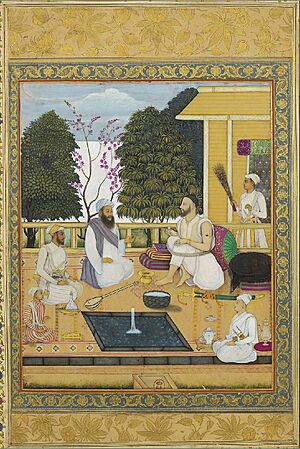
In 1518, Sultan Quli started the Qutb Shahi dynasty. His grandson, Muhammad Quli Qutb Shah, founded Hyderabad in 1591. He built famous landmarks like the Charminar and Mecca Masjid. In 1687, the Mughal Empire took control of Hyderabad after a long fight.
Hyderabad in Modern Times
In 1724, Asaf Jah I became the ruler of the Deccan region. He started the Asaf Jahi dynasty, and his family became known as the Nizams of Hyderabad. Hyderabad became their official capital in 1769.
To protect their state, the Nizams made an agreement with the East India Company in 1798. This allowed the British Indian Army to be stationed in Secunderabad, near Hyderabad.
Before 1874, Hyderabad did not have many modern factories. But with the arrival of railways in the 1880s, industries grew. In the early 1900s, Hyderabad became a modern city with new transport, water systems, electricity, and universities. The Nizams ruled Hyderabad as a princely state under the British Raj.
After India's Independence
When India became independent in 1947, the Nizam wanted Hyderabad to remain separate. However, in 1948, the Indian Army took control of Hyderabad State. It then became part of the Indian Union.
In 1956, India's states were reorganized based on language. Hyderabad became the capital of the newly formed state of Andhra Pradesh. Later, in 2014, Andhra Pradesh was divided. The new state of Telangana was formed, and Hyderabad became its capital. For a period, it also remained the capital of Andhra Pradesh.
Hyderabad's Geography
Hyderabad is located in southern Telangana, along the Musi River. It is part of the Deccan Plateau. The Greater Hyderabad area covers about 650 square kilometers. The city is mostly built on hilly land made of granite, with many small hills. The highest point is Banjara Hills.
Hyderabad has many lakes, often called sagar, which means "sea." These include Hussain Sagar, Osman Sagar, and Himayat Sagar. In 1996, the city had 140 lakes and 834 water tanks.
Hyderabad's Climate
Hyderabad has a tropical climate. Summers, from March to June, are hot and dry. Temperatures often go above 40 degrees Celsius. The coolest months are December and January, when temperatures can drop to about 10 degrees Celsius.
Heavy rain comes from the south-west summer monsoon between June and October. This brings most of Hyderabad's yearly rainfall. The city gets a lot of sunshine throughout the year. Hyderabad is also recognized as a "National Clean Air City."
Protecting Nature in Hyderabad

Hyderabad's lakes and hills are home to many plants and animals. The city has several national parks and a wildlife sanctuary to protect these areas. The Nehru Zoological Park is India's first zoo with a lion and tiger safari park.
Other important natural spots include the Kotla Vijayabhaskara Reddy Botanical Gardens and various lakes like Ameenpur Lake and Shamirpet Lake. These places attract many local and migratory birds. Different organizations work to protect the environment and wildlife in Hyderabad.
How Hyderabad is Managed
Hyderabad is the common capital for both Telangana and Andhra Pradesh. This arrangement is set to last for a period of up to ten years. The city's administration, including the Greater Hyderabad Municipal Corporation, serves both states during this time.
City Services
The HMWSSB (Hyderabad Metropolitan Water Supply & Sewage Board) handles water supply, rainwater harvesting, and sewage services. Electricity is managed by the Telangana Southern Power Distribution Company Limited (TSPDCL). The city also has many fire stations and post offices.
Keeping Hyderabad Clean
Hyderabad produces a lot of solid waste every day. This waste is collected and taken to a dumpsite. The city has a project called Integrated Solid Waste Management to handle this.
However, rapid growth has led to more industrial waste and pollution in the air, noise, and water. The Telangana Pollution Control Board (TPCB) works to control this pollution. Efforts are being made to improve air quality and protect water sources.
Healthcare in Hyderabad
The Commissionerate of Health and Family Welfare oversees health services in Hyderabad. The city has many government and private hospitals, providing thousands of hospital beds. There are also many individual clinics.
Hyderabad offers different types of medical treatments, including Unani, homoeopathic, and Ayurvedic methods. The city aims to provide good healthcare for all its residents.
People of Hyderabad
Hyderabad is a very populated city. In 2011, it was the fourth most populous city in India. Many people have moved to Hyderabad from other parts of India. The city has a good balance of males and females. Most people in Hyderabad can read and write, which is higher than the national average.
Different Communities in Hyderabad
People from Hyderabad are often called "Hyderabadi." Most residents speak Telugu or Urdu. There are also smaller groups of Arab, Marathi, Marwari, and Pathan communities.
Hyderabadi Muslims are a special community with their own history, language, food, and culture. In the past, people from places like Arabia, Africa, Iran, and Turkey also lived here. These communities have made Hyderabad a diverse place.
Religions in Hyderabad
Hyderabad is home to many religions. Most people are Hindus, but there is also a very large number of Muslims. You can find Christians, Sikhs, Jains, Buddhists, and Parsis too. The city has many beautiful churches, mosques, and temples. This shows how different religions live together peacefully in Hyderabad.
Languages Spoken in Hyderabad
Telugu and Urdu are the two official languages of Hyderabad. Most people in the city can speak both. The Telugu spoken here is called Telangana Baasha, and the Urdu is called Deccani.
English is also very important for business, government, and education. Many people also speak other languages like Bengali, Hindi, Kannada, Marathi, and Tamil, making Hyderabad a truly multilingual city.
Hyderabad's Cityscape
City Areas and Neighborhoods
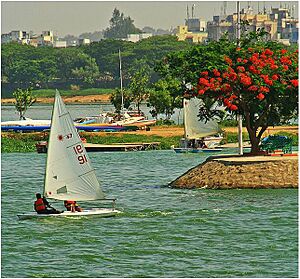
The old part of Hyderabad, called the Purana Shahar, was built by Muhammad Quli Qutb Shah. The "New City" is on the northern side of the Musi River. Many bridges connect these two parts, with Purana Pul being the oldest. Hyderabad is also connected to Secunderabad by Hussain Sagar.
In the Old City, you'll find historic places like the Charminar, Mecca Masjid, and Chowmahalla Palace. There are also traditional markets like the Pearl Market and Laad Bazaar. North of the river, you'll find hospitals, colleges, and business areas like Abids.
The northwest part of the city has fancy residential and business areas like Banjara Hills and Jubilee Hills. The "Cyberabad" area in the southwest is where many technology and pharmaceutical companies are located.
Famous Landmarks in Hyderabad
Hyderabad has many beautiful old buildings from the Qutb Shahi and Nizam eras. These buildings show a mix of Indian, Islamic, and European styles. After a big flood in 1908, the city was rebuilt, and many civic monuments were constructed, especially during the rule of Mir Osman Ali Khan, who is known as the maker of modern Hyderabad. In 2012, Hyderabad was named the first "Best heritage city of India."
The Charminar is a symbol of Hyderabad. It's a square building with four tall minarets at each corner. The Charminar, Golconda Fort, and the Qutb Shahi tombs are very important historical sites. The Chowmahalla Palace was a royal palace of the Nizams, showing different architectural styles. Other beautiful palaces include Falaknuma Palace and King Kothi Palace. Many civic buildings like the Telangana High Court and Osmania General Hospital were built in the Indo-Saracenic style.
{{Wide image| Chowmahalla Palace Hyderabad.JPG|680px|The Chowmahalla Palace—a main palace of the Nizam's, built by Salabat Jung in 1750.]]
Hyderabad's Economy
Hyderabad is one of India's most productive cities. It contributes a lot to Telangana's economy. The city is a major center for banking and finance. Most people in Hyderabad work in the service industry.
Hyderabad was once known as the "City of Pearls" because of its pearl trade. Until the 18th century, it was the only global trading center for Golconda diamonds. Industries started growing in the late 1800s with the help of railways.
From the 1950s to the 1970s, many big Indian companies were set up in Hyderabad. Since the 1990s, the city has become a huge hub for information technology (IT) and pharmaceuticals. It's known as "India's pharmaceutical capital" and the "Genome Valley of India." Hyderabad is also called Cyberabad because of its strong IT sector.
The development of HITEC City, a special area for technology, has brought many international companies to Hyderabad. Big names like Microsoft, Apple, Amazon, and Google have offices here. Hyderabad is also becoming an important center for the automobile industry.
Hyderabad's Culture
Hyderabad became a major cultural center in India as the Mughal Empire declined. Many artists moved to the city, making its culture even richer. This mix of cultures led to a blend of Hindu and Muslim traditions, which Hyderabad is famous for. Both Telugu and Urdu are official languages.
People in Hyderabad celebrate many festivals, including Ganesh Chaturthi, Diwali, and Bonalu for Hindus, and Eid ul-Fitr and Eid al-Adha for Muslims. Traditional clothing in Hyderabad shows a mix of styles, with men wearing sherwani and women wearing khara dupatta.
Literature and Poetry
In the past, rulers in Hyderabad supported artists and writers. This led to cultural events like mushairas (poetry gatherings) and Qawwali (devotional songs). The Qutb Shahi dynasty encouraged Deccani literature, which includes some of the earliest writings in Urdu.
The Nizams also promoted Urdu as a language for the court and education. Hyderabad still celebrates its literary traditions with the annual Hyderabad Literary Festival. There are many organizations and libraries that help literature grow in the city.
{{Wide image| A typical charminar evening.jpg|680px|An evening view of the Charminar with other historic buildings and markets.]]
Music and Films
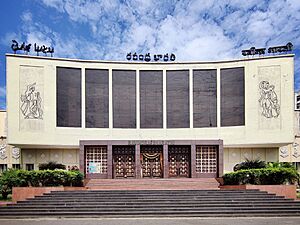
Music and dances from South India, like Kuchipudi and Bharatanatyam, are popular. However, North Indian music and dance also became popular during the Mughal and Nizam rule. Hyderabad has its own unique music styles, like marfa music and Dholak ke Geet.
The city is home to the Telugu film industry, known as Tollywood. It is one of the biggest film industries in India. Hyderabad has also hosted international film festivals. Ramoji Film City in Hyderabad is recognized by Guinness World Records as the world's largest film studio.
Art and Handicrafts

The Hyderabad region is known for its unique painting styles, which are part of Deccan painting. These styles often use bright colors and show local landscapes and culture.
Many skilled artisans were attracted to Hyderabad by the rulers. Crafts like Bidriware, a metalwork art, and Zari and Zardozi embroidery (using gold and silver threads) became popular. Kalamkari, a hand-painted cotton textile, is another craft found here. You can see examples of Hyderabad's arts and crafts in various museums, like the Salar Jung Museum.
Delicious Hyderabadi Food
Hyderabadi food is famous for its many rice, wheat, and meat dishes, and its special use of spices. Hyderabad is recognized by UNESCO as a "creative city of gastronomy" because of its amazing food.
The most famous dishes are Hyderabadi biryani and Hyderabadi haleem. These foods mix flavors from Mughlai and Arab cuisines. Other popular local dishes include nihari and sweet desserts like qubani ka meetha.
Media in Hyderabad
Hyderabad has a long history of newspapers, with one of the earliest starting in the 1780s. Today, major newspapers are published in Telugu, English, and Urdu.
Radio broadcasting began in Hyderabad in 1935. Now, there are many FM radio channels available. Television broadcasting started in 1974 with Doordarshan, a government channel. Later, private satellite channels became available. Internet access started in the 1990s, and high-speed public WiFi was introduced in 2015.
Education in Hyderabad
Schools in Hyderabad follow different education systems. Most students attend private schools. You can study in English, Hindi, Telugu, or Urdu. After finishing secondary school, students can go to colleges for higher education.
Hyderabad has many universities, including private, state, and central universities. Osmania University, founded in 1918, is one of the oldest and most popular universities in India. The Dr. B. R. Ambedkar Open University was India's first distance-learning university.
The city is also home to many special centers for science and research. These include places for biomedical sciences, biotechnology, and pharmaceuticals. Hyderabad has several medical schools and teaching hospitals. There are also many other important institutions for law, technology, and management.
Sports in Hyderabad
Hyderabad has hosted many national and international sports events. These include the 2003 Afro-Asian Games and the 2009 World Badminton Championships. The city has great venues for sports like field hockey, athletics, football, and cricket.
The Rajiv Gandhi International Cricket Stadium is the home ground for the Hyderabad Cricket Association. Hyderabad has hosted many international cricket matches, including World Cup games. The city is home to the Indian Premier League (IPL) team Sunrisers Hyderabad. Hyderabad also has a professional football club, Hyderabad FC.
During British rule, Secunderabad became a famous sports center with race courses and polo fields. Today, clubs like the Hyderabad Race Club are known for horse racing. Motorsports are also popular, with events like drag races and off-road rallying. In 2023, Hyderabad hosted India's first FIA Formula E World Championship race.
Getting Around in Hyderabad
In Hyderabad, people use many ways to get around. These include government buses and light railways, as well as private taxis and auto rickshaws. These services carry millions of passengers every day.
The Hyderabad Metro, a modern light-rail system, opened in 2017. It has three lines and many stations, making it one of the largest metro networks in India. Hyderabad also has a Multi-Modal Transport System (MMTS), which is a suburban rail service. Buses operate from the Mahatma Gandhi Bus Station in the city center.

There are millions of vehicles in Hyderabad, mostly two-wheelers and cars. To help with traffic, the city has built inner and outer ring roads, flyovers, and underpasses.
Hyderabad is connected to other states by several National Highways. These important roads link Hyderabad to cities across India. The city also has five state highways.
Air travel is handled by Rajiv Gandhi International Airport (RGIA), which opened in 2008. It can handle many passengers and a lot of cargo. In 2020, RGIA was recognized as one of the best airports for its environment and ambiance.
Images for kids
See also
 In Spanish: Haiderabad (India) para niños
In Spanish: Haiderabad (India) para niños


